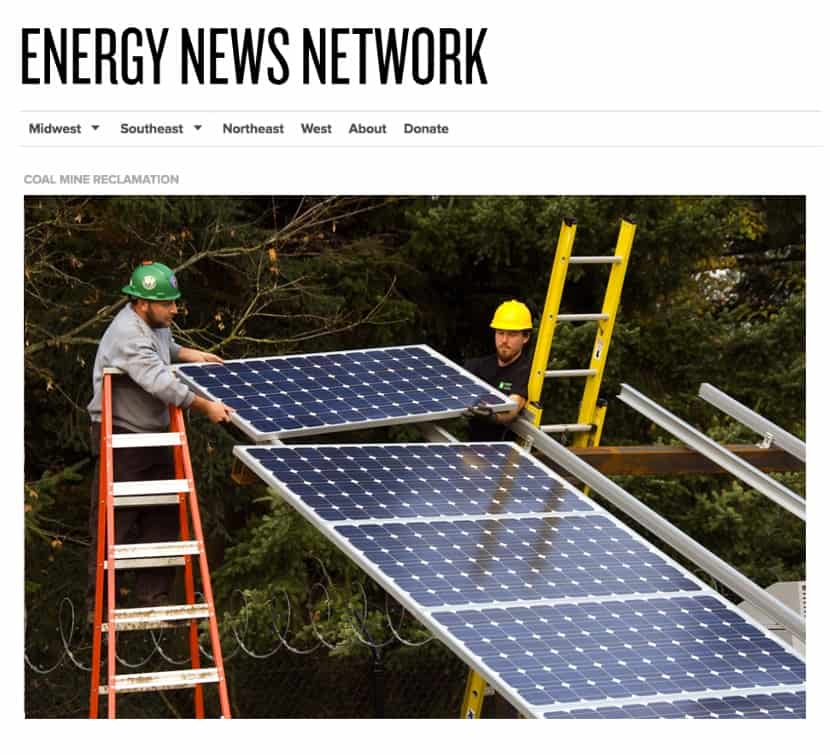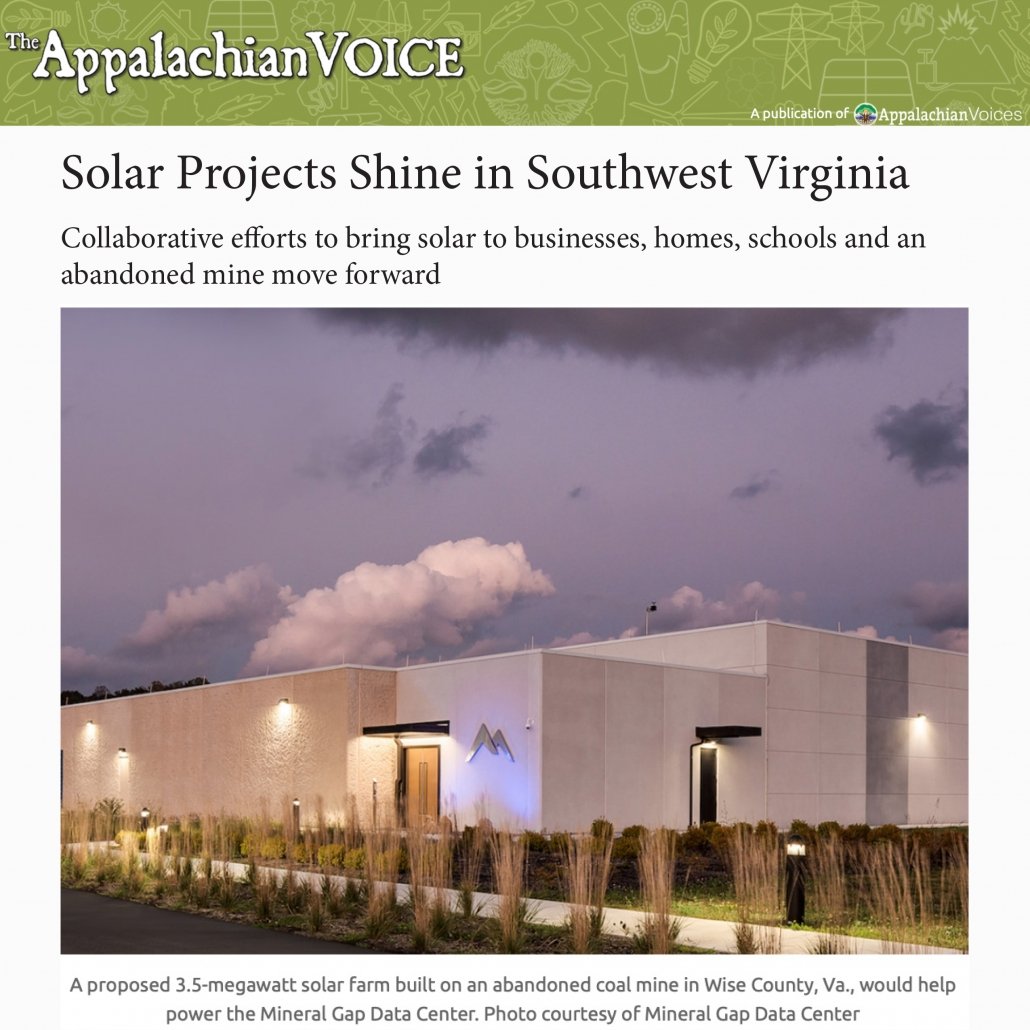By Elizabeth McGowan
The proposed project is set to provide up to 3.5 megawatts of renewable power to data centers in Wise County.
A groundbreaking project to “re-energize” a coal mine deep in southwestern Virginia as a solar farm was green-lighted Thursday with the full $500,000 in federal funds the developers had requested late last year.
Sun Tribe Solar, based in Charlottesville, paired with the owner of the Mineral Gap Data Centers on the proposed $4.6 million solar project on the Wise County site, which was last mined in 1957.
By providing up to 3.5 megawatts of renewable power to the on-site data centers, the project would decrease the centers’ operating budget and peak-load demands on the local distribution grid.
The Wise County solar farm was one of 10 economic development projects in the state’s coal country approved for federal grants by the Virginia Department of Mines, Minerals and Energy. Gov. Ralph Northam and U.S. Rep. Morgan Griffith announced the winners via a news release.
Taylor Brown, Sun Tribe Solar’s chief technical officer, said the $500,000 grant will be spent to meet the required environmental standards on the mine site.
“Today, we’re one step closer to making this project a reality,” Brown said. “We’re pleased that Virginia’s Department of Mines, Minerals and Energy is making a critical investment necessary to move the commonwealth towards a more sustainable tomorrow.”
Mineral Gap Data Centers spokesperson Marc Silverstein said the business is proud to be part of an initiative to grow green energy into a long-term economic opportunity in the region.
“We see this as the opening act for solar power and renewables in Wise County and all of southwestern Virginia,” Silverstein said.
Construction of the 65,000-square-foot Mineral Gap Data Centers, the only ones in Wise County, was completed in April 2016 on 22 acres in the Lonesome Pine Business and Technology Park. The centers serve government and commercial clients.
The company also has a facility in northern Virginia’s Loudoun County and wants to expand in the state. It views coal country as a secure technology corridor because the region is remote and mountainous.
Sun Tribe focuses on Virginia, mid-Atlantic Sun Tribe has developed a portfolio of 26 MW of solar and energy storage in Virginia and other mid-Atlantic states. The company is working on another 80 MW of large-scale solar projects in the region.
In its application for the grant, the 3-year-old company estimated that construction at the Wise County site could begin Sept. 30 and be completed by the end of the year. The array would cover between 6 and 9 acres.
The Sun Tribe-Mineral Gap proposal was one of 19 mineland-related reuse applications submitted to the state mining agency last fall. A six-member, state-appointed committee charged with reviewing the proposals had the leeway to approve any number of the projects as long as the total cost didn’t exceed $10 million.
Virginia was allotted that amount in 2018 via the federal Abandoned Mine Land Pilot Program, which is aimed at reclaiming minelands and boosting economies in Appalachia. Funding for 10 Virginia projects announced Thursday — ranging from $47,420 to $2.2 million in award money — adds up to a total of close to $9.1 million.
Before the money is released, the U.S. Department of the Interior’s Office of Surface Mining Reclamation and Enforcement will be reviewing the projects. Sun Tribe and its partners expect to hire about 26 employees during the engineering and construction phases. In addition, they said plans call for giving students in the solar training program at Mountain Empire Community College in Big Stone Gap, Virginia, hands-on experience with part of the project.
Brown said Sun Tribe’s dedication to using solar in new and exciting ways for the data centers is a “great example of how renewable energy can help support the creation of good, family-supporting jobs.”
The proposal estimates that the annual land lease, as well as operation and maintenance of the array, will inject roughly $1.2 million into the local economy over the array’s 35-year lifespan.
The project team also noted that it will coordinate with federal, state and local agencies to develop “best practices.” That includes planting pollinator-friendly seed mixes on the array site and hiring local companies to conduct engineering and environmental studies.
A transition model for Central Appalachia since 1977, Congress has required coal companies to pay a severance tax into the federal Abandoned Mine Lands Fund for each ton they mined. The fund was designed to address minelands abandoned prior to 1977 that were ignored or inadequately restored.
The Abandoned Mine Lands Pilot Program was launched in 2016 and funded with U.S. Treasury money. Kentucky, West Virginia and Pennsylvania received $30 million apiece because they have the majority of the high priority abandoned mine sites.
By 2017, the total budget jumped to $105 million and expanded to Virginia, Ohio and Alabama. Virginia received $10 million. Last year, Native American tribes also were included in the $115 million budget.
In their application to the state, Sun Tribe and Mineral Gap highlighted the backing they had from the Solar Workgroup of Southwest Virginia. The coalition of nonprofits, community action agencies, colleges, state agencies and planning district commissions promotes energy innovation in Wise County and Virginia’s six other coalfield counties.
The coalition has clearly stated that the solar-industry value chain — from component manufacturing and sales to engineering and installation — won’t reach fruition until there’s proof that large-scale solar development works in southwestern Virginia and that such an enterprise can support solar and non-solar jobs alike.
Virginia alone has more than 71,000 acres affected by coal mining, according to state figures.
Devin Welch, Sun Tribe’s chief strategy officer, said his company views this first coal mine project as a model for Central Appalachia.
“There is no more poignant example of our society’s transition from the energy sources of the past to a brighter, cleaner energy future than converting a former coal site to a place where solar energy will power essential digital technology,” Welch said. “We’re confident that this is just the beginning.”


